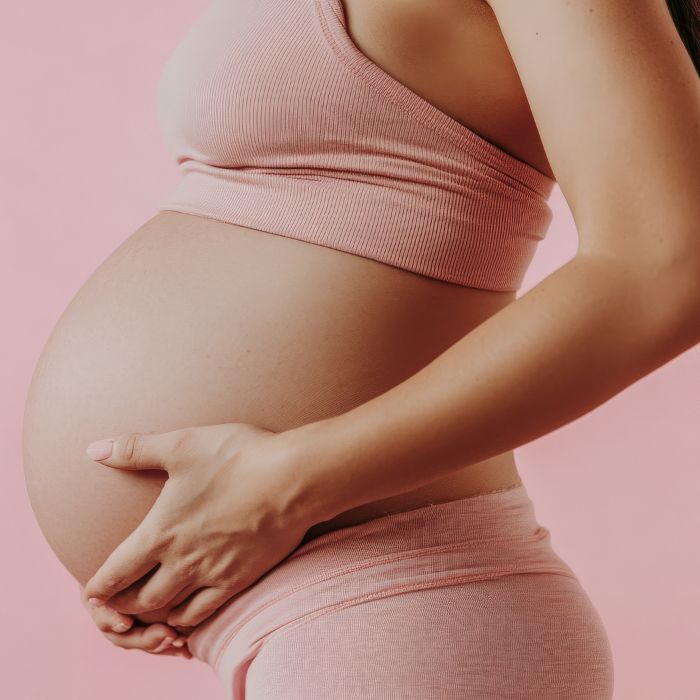Pregnancy and skin

Welcome on our new website !
0,00€
Pregnancy is a unique time that transforms a woman's body, and the skin is no exception. These skin changes are primarily caused by the hormonal fluctuations of pregnancy .
In this article, we explain everything that changes in the skin during pregnancy , and give you our best simple and suitable advice for taking care of it.
During pregnancy, the body undergoes a real hormonal upheaval with a significant increase in estrogen and progesterone . While these hormones can promote vascularization and hydration of the skin, they can also cause certain skin problems.
During pregnancy, blood flow increases by approximately 50% to ensure adequate oxygen and nutrient supply to the baby¹. This increase has a direct impact on the skin with the appearance of:
Under the effect of hormonal levels during pregnancy, the hydrolipidic film can become less protective and less effective with several modifications²:
Unlike some pregnant women, others may experience an increase in their skin's sebum production . This increased production is mainly due to the increase in androgen and progesterone hormones, which stimulate the activity of the sebaceous glands. As a result, the skin may become oilier , particularly on the nose, forehead, and chin, and may increase the risk of spots and pregnancy acne.³
Perhaps you have experienced it, when pregnant, your skin can become more sensitive and react more intensely to its environment (pollution, UV, cosmetic products, etc.). This skin hyper-reactivity is explained by an increase in cortisol levels , but also by changes in skin pH and an imbalance in the skin microbiota . These three conditions promote inflammation , making the skin more prone to irritation, redness and acne breakouts. Thus, cosmetic products that were usually well tolerated before pregnancy can suddenly cause reactions or redness⁴.
Hyperpigmentation during pregnancy is caused by an increase in the hormones estrogen and progesterone, which stimulate melanocytes, the cells responsible for melanin production. This leads to darkening of certain areas such as the nipples, armpits, the black line on the stomach, and sometimes the face (melasma or pregnancy mask), a phenomenon accentuated by sun exposure⁴.

Life as a mother-to-be isn't always easy, and during pregnancy, various skin concerns can arise. Around 90% of pregnant women experience skin changes that can seriously impact their quality of life and mood ⁴.
Stretch marks are arguably the biggest concern for expectant mothers. 75% of pregnant women are prone to stretch marks. ⁵ And in addition to their unsightly appearance, they can cause increased emotional and psychological distress in around 25% of women.⁵ They appear as pink or purple streaks, mainly on the stomach, hips, thighs, and breasts.
They result from rapid weight gain and significant stretching of the skin , leading to a breakdown of collagen and elastin fibers . Added to this mechanical stress is the impact of pregnancy hormones , which reduce the skin's ability to repair itself.
Many pregnant women experience drier, itchy, and tight skin . This itching (pruritus of pregnancy) frequently appears on the stomach, breasts, and legs. The causes? Stretching of the skin, which loses its elasticity, and hormonal changes that disrupt sebum production and dry out the skin.
Promoted by increased estrogen and progesterone, the linea nigra , or black line , is a vertical hyperpigmentation that appears in the middle of the abdomen in approximately 30 to 90% of pregnant women between the 2nd and 3rd trimester⁶. The black line usually extends from the pubis to the navel and can reach the sternum. It is often more pronounced in women with dark skin. In most cases, the black line gradually fades after delivery (between 3 and 6 months after birth), as female hormones return to normal.
Characterized by dry skin, red patches and more or less intense itching , pregnancy eczema is quite common, affecting around 20 to 30% of pregnant women . It generally develops before the 3rd trimester. In 80% of cases, it occurs for the first time while it is pre-existing for 20% of women⁷. Pregnancy eczema is favored by hormonal changes in pregnant women which increase inflammation.

Also known as melasma, pregnancy mask is characterized by the formation of more or less extensive brown spots on the forehead, cheekbones, and upper lip. It results from hyperpigmentation induced by variations in estrogen observed during pregnancy, but also from genetic predispositions. Thus, pregnancy mask affects between 15% and 50% of pregnant women , with a higher prevalence in women with dark skin⁸. It frequently occurs between the 4th and 6th month of pregnancy. In those affected, melasma can be associated with increased anxiety (45% of people)⁹.

During pregnancy, some women experience acne breakouts on their faces. Approximately 43% of expectant mothers are affected between the 2nd and 3rd trimester¹⁰. These acne breakouts are caused by increased sebum production due to changes in estrogen. This is more specifically called hormonal acne . Some women develop acne for the first time during their pregnancy, which can cause discomfort or even anxiety.
During pregnancy, the skin undergoes many changes, some of which have varying degrees of impact on the mother-to-be's quality of life and mood. Fortunately, it's possible to adopt a few steps and a tailored skincare routine to protect the skin and relieve discomfort.
It is important to help the skin of the body, and especially that of the belly, to adapt to the stretching and changes induced by the hormones to which it is subjected during the 9 months of pregnancy.
To minimize the risk of stretch marks appearing and limit skin dryness , it is important to focus on:
The Topicrem answer:
During pregnancy, your facial skincare routine varies little from a good, traditional routine. In addition, depending on your beauty concerns, a few additional steps and treatments may be necessary.
The Topicrem answer:
To target hormonal acne during your pregnancy, discover our AC CONTROL routine with our Purifying Micellar Water which will leave your skin fresh and clear and our Anti-Imperfection Balancing Treatment which will correct your spots by rebalancing the skin microbiome.
To prevent and reduce the pregnancy mask , turn to our MELA range and its Anti-Dark Spot Radiance Serum with intensive corrective action as well as its Unifying Day Cream which will protect your skin thanks to double SPF50+ protection and anti-blue light.
Adopting a healthy lifestyle during pregnancy will also help you limit the impact of hormonal changes on your skin and preserve its radiance and health. Here are some recommendations:
Drink enough:
Adopt a balanced diet:
Get enough sleep:
Limit stress:
Pregnancy transforms the body, mind, and even the skin, which is subject to the stretching of the belly and hormonal changes. To help you experience this period with peace of mind, Topicrem supports you daily to make this magical moment a moment of well-being.
TOPICREM formulas have all been designed to provide protective hydration and preserve the skin barrier of sensitive skin for the whole family.
To do this, the laboratory relies on its expertise derived from pharmaceutical excellence:
Through the comfort and emotional well-being they provide, our treatments help you feel confident in your skin and in yourself, to better reveal yourself to others, and thus to fully enjoy every moment of life.
Bibliographic references:
¹Hytten F. Blood volume changes in normal pregnancy. Clin Haematol. 1985 Oct;14(3):601-12. PMID: 4075604.
Link: https://pubmed.ncbi.nlm.nih.gov/4075604/
²Chen F, Huang D. Study on the skin status of mid-pregnancy women based on lipidomics. J Cosmet Dermatol. 2021 Mar;20(3):955-963. doi:10.1111/jocd.13866. Epub 2020 Dec 9. PMID: 33251666.
Link: https://pubmed.ncbi.nlm.nih.gov/33251666/
³Motosko CC, Bieber AK, Pomeranz MK, Stein JA, Martires KJ. Physiologic changes of pregnancy: A review of the literature. Int J Womens Dermatol. 2017 Oct 21;3(4):219-224. doi: 10.1016/j.ijwd.2017.09.003. PMID: 29234716; PMCID: PMC5715231.
Link: https://pmc.ncbi.nlm.nih.gov/articles/PMC5715231/
⁴Gupta SN, Madke B, Ganjre S, Jawade S, Kondalkar A. Cutaneous Changes During Pregnancy: A Comprehensive Review. Cureus. 2024 Sep 23;16(9):e69986. doi:10.7759/cureus.69986. PMID: 39445254; PMCID: PMC11497768.
Link: https://pmc.ncbi.nlm.nih.gov/articles/PMC11497768/
⁵Karhade K, Lawlor M, Chubb H, Johnson TRB, Voorhees JJ, Wang F. Negative perceptions and emotional impact of striae gravidarum among pregnant women. Int J Womens Dermatol. 2021 Nov 3;7(5Part B):685-691. doi: 10.1016/j.ijwd.2021.10.015. PMID: 35028366; PMCID: PMC8714569.
Link: https://pubmed.ncbi.nlm.nih.gov/35028366/
⁶Cohen PR. Linea Nigra: Case Report of a Woman With a Pregnancy-Associated Linear Streak of Cutaneous Hyperpigmentation on Her Abdomen From the Umbilicus to the Pubic Symphysis. Cureus. 2023 Nov 6;15(11):e48408. doi:10.7759/cureus.48408. PMID: 38074022; PMCID: PMC10701200.
Link: https://pmc.ncbi.nlm.nih.gov/articles/PMC10701200/#:~:text=Similar%20to%20this%20patient%2C%20clinical,after%20delivery%20of%20the%20newborn.
⁷Munera-Campos M, Carrascosa JM. Atopic Dermatitis: Fertility, Pregnancy, and Treatment Perspectives. Am J Clin Dermatol. 2024 Jan;25(1):55-66. doi:10.1007/s40257-023-00821-4. Epub 2023 Oct 30. PMID: 37904055.
Link: https://pubmed.ncbi.nlm.nih.gov/37904055/
⁸Basit H, Godse KV, Al Aboud AM. Melasma. [Updated 2023 Aug 8]. In: StatPearls [Internet]. Treasure Island (FL): StatPearls Publishing; 2025 Jan-. Available from: https://www.ncbi.nlm.nih.gov/books/NBK459271/#
⁹Platsidaki E, Efstathiou V, Markantoni V, Kouris A, Kontochristopoulos G, Nikolaidou E, Rigopoulos D, Stratigos A, Gregoriou S. Self-Esteem, Depression, Anxiety and Quality of Life in Patients with Melasma Living in a Sunny Mediterranean Area: Results from a Prospective Cross-Sectional Study. Dermatol Ther (Heidelb). 2023 May;13(5):1127-1136. doi:10.1007/s13555-023-00915-1. Epub 2023 Mar 30. PMID: 36995579; PMCID: PMC10149543.
Link: https://pmc.ncbi.nlm.nih.gov/articles/PMC10149543/#:~:text=Melasma%20patients%20presented%20statistically%20significantly,health%2Drelated%20quality%20of%20life.
¹⁰Ly S, Kamal K, Manjaly P, Barbieri JS, Mostaghimi A. Treatment of Acne Vulgaris During Pregnancy and Lactation: A Narrative Review. Dermatol Ther (Heidelb). 2023 Jan;13(1):115-130. doi:10.1007/s13555-022-00854-3. Epub 2022 Nov 29. PMID: 36447117; PMCID: PMC9823189.
Link: https://pmc.ncbi.nlm.nih.gov/articles/PMC9823189/#:~:text=While%20epidemiologic%20data%20are%20limited,pregnancy%20%5B1–3%5D.

Managing healing properly isn't just about waiting for the wound to heal on its own, and poor man...
Read the article
Thin, fragile, and still immature, baby's skin requires special attention to stay soft, moisturiz...
Read the article
Your baby's skin is different from yours. Thinner and more permeable, it is still immature and pa...
Read the article
Cradle cap is a common concern among infants, often worrying new parents. These small, yellowish ...
Read the article



